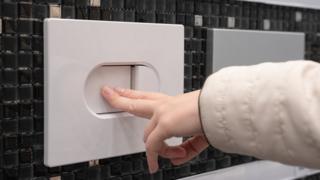Image copyright
Getty Images
Dual flush toilets allow the option of a large or small flush
Billions of litres of water are being wasted every week because of an innovation intended to cut water use.
About 400 million litres of water are estimated to leak from UK toilets every day.
But much of this can be blamed on dual-flush toilets, designed to save water, the BBC has learned.
One water company says dual-flush toilets are now wasting more water than they save due to a combination of leaky mechanisms and confusing flush buttons.
Dual-flush toilets allow the option of a small or large flush – typically four or six litres – to only use the water necessary for urine or faeces.
Water-saving organisation Waterwise estimates that between 5% and 8% of toilets are leaking and says most of these are dual flush.
- England’s future water supplies at ‘serious risk’
- London’s leakiest streets revealed
Andrew Tucker, water efficiency manager at Thames Water, the UK’s largest water and sewerage company, says the problem is getting worse as bathrooms are done up.
“Because we’ve got so many [loos] that continuously flow all through the day, collectively that water loss is now exceeding the amount of water they should be saving nationally,” he said.
“The volume of water loss is getting bigger every day as more people refurbish and retrofit their older toilets and as we build more homes, so we’re actually adding a problem.”
The 400 million litres of water lost daily from loos is enough to supply 2.8 million people – the populations of Edinburgh, Cardiff, Belfast, Manchester, Sheffield, Liverpool and Bristol combined.
Rising demand for water harms the natural environment and has been strongly linked to rivers running dry.
Most dual-flush toilets use a drop valve system (right) rather than a siphon (left)
Most dual-flush toilets use a drop valve system, which was allowed onto the UK market back in 2001 due to a change in regulations.
The Bathroom Manufacturers Association (BMA) admits the drop valve system is more prone to leakage than the traditional siphon.
The drop valve, which opens for a flush, sits underwater at the bottom of the cistern. Debris – like porcelain, grit or calcium – easily catches in the valve causing leaks which can then run constantly.
The siphon, on the other hand, works when the flush handle forces a volume of water over a lip down into a tube linked to the pan. Water’s only way out is above the water line, making leakage very rare.
How can I tell if I have a leaky loo?
A leak can be silent but there may be a small ripple at the back of the bowl.
Some water companies suggest wiping the back of the bowl dry 30 minutes after a flush and placing a square of toilet paper there overnight – if it is wet or torn in the morning there is a leak.
Leak strips can be placed in a toilet bowl or food colouring can be put in the cistern between flushes to see whether it shows up in the toilet pan.
Water smart meters will indicate high usage or go up constantly – even when residents are sleeping.
Thomas Dudley Ltd, one of the UK’s largest plumbing manufacturers, has a testing station that puts any new mechanism through its paces with 200,000 constantly repeated flushes, taking four months.
Managing director Jason Parker says: “A siphon will not leak whereas an outlet valve – if we look at the figures we’ve got – they could leak within a week of installation. It could be two years but they will leak.”
Siphons are now being made dual flush, so he wants drop valves outlawed despite the fact they are his biggest seller and such a move could harm his business.
“If we’re serious about wasting water and we want to stop it, the only way to do that is put a siphon back in,” he says.
The BBC’s Tom Heap visited a testing station at Thomas Dudley Ltd
Water companies and campaigners are asking bathroom manufacturers to “design the problem out of existence”.
Although BMA chief executive Tom Reynolds admits drop valves are more likely to leak, he does not want them banned.
“Individual companies have gone into looking at the issue… but we haven’t cracked what the underlying issue is,” he says.
“There is a commercial and moral imperative to ensure our products reduce leakage wherever possible.”
But water is also lost by confusion over buttons. Style over substance has made many unclear which button does what.
Thames Water says in recent research as many as 50% of customers chose the wrong button – or pushed both.
For more on this story listen to Costing the Earth on BBC Radio 4 at 15:30 BST on Tuesday 29 September or afterwards on BBC Sounds.
















